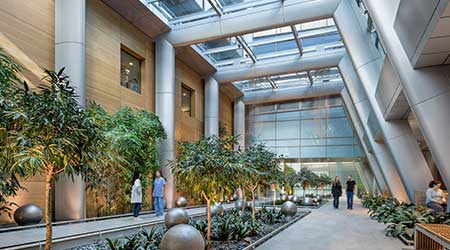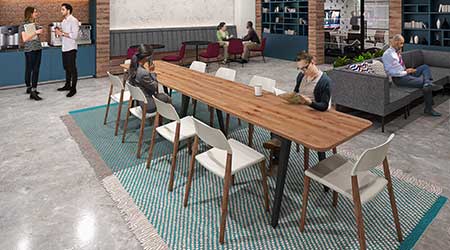 Proper calibration and operation of daylight dimming controls can enhance occupant visual comfort and workplace experiences.David Wakely
Proper calibration and operation of daylight dimming controls can enhance occupant visual comfort and workplace experiences.David WakelyHow to Focus on Health and Wellness in Existing Buildings
Smart lighting and daylighting, better thermal comfort, and enhanced indoor air quality are three crucial aspects of improving occupant health and wellness.
We spend more than 90 percent of our time indoors and the impact of building design and operations on human health is well documented. In an age of competitive commercial real estate markets, creating a differentiator is a necessity for building owners and facility managers.
The built environment can be used to attract and retain tenants, and in turn, attract and retain staff for those tenants — benefiting the bottom line for both building owners and tenants. Strategies ranging from low to high effort and cost can be incorporated into existing buildings, from optimizing indoor air quality (IAQ) to providing amenities on-site like spaces for yoga and relaxation. The Organisation for Economic Cooperation and Development anticipates that with up to two-thirds of the building floor area that will exist in 2050 already in use, there are environmental co-benefits to retrofitting existing buildings, including the potential reduction of greenhouse gas emissions in both building operations and embodied carbon.
Benefits of design for people
Traditionally, there has been a focus on space and operational efficiency that has at times neglected to create a healthy environment for building occupants. As noted by the World Green Building Council’s report, “Health, Wellbeing & Productivity in Offices,” for typical business operating expenses, staff costs account for 90 percent of the total, with rent and energy accounting for 9 percent and 1 percent respectively. This breakdown shows that investing in health-promoting features can really benefit an organization’s bottom line and help attract tenants into a building.
Due in large part to the understanding on how healthy buildings can benefit people, in recent years two certification systems have emerged on the market promoting health and wellbeing. The WELL Building Standard and the Fitwel Certification System provide comprehensive and evidence-based frameworks for new and existing buildings.

(Employee hubs with centralized kitchens or kitchenettes encourage building occupants to move more throughout the day. These spaces also promote socialization, contributing to occupants’ mental health and well-being by combatting workplace loneliness. Photo credit: Stantec)
In 2016, Dodge Data & Analytics identified three major features of healthy buildings: better lighting and daylighting, enhanced thermal comfort, and enhanced indoor air quality. A close look at those areas reveals many opportunities for improvements to existing buildings.
Indoor air quality
Poor IAQ costs the U.S. economy a whopping $168 billion per year due to direct medical care and absenteeism. Another big problem is “presenteeism,” when employees come to work when still not fully recovered, resulting in a big loss both in quantity and quality of work performed. In 2004, a study published by the Harvard Business Review found that “presenteeism” is 7.5 times more costly than illness-related absenteeism, because of the increased risk of employees infecting their coworkers.
Sick building syndrome is caused by being in a building or enclosed space with poor IAQ or poor lighting. Symptoms include throat irritation, breathing issues, runny nose, tightness in chest, allergies, headaches, body aches, lack of focus and concentration, and fever. The World Health Organization estimates that up to 64 million U.S. office workers and teachers are at risk of suffering from sick building syndrome. According to the U.S. Consumer Product Safety Commission, about 30 percent of all new and remodeled buildings have poor IAQ. Those are mind boggling numbers. Studies found that more than 75 percent of the time, poor IAQ in buildings is HVAC-related.
Efficient and well-designed HVAC strategies can promote health and wellbeing within an existing space through better IAQ. New construction projects should invest in better HVAC design, including dedicated outside air systems, natural ventilation, radiant systems, displacement ventilation systems, IAQ sensors, and other strategies that can not only promote better IAQ but also save energy and provide enhanced thermal comfort.
The challenge lies with existing buildings where occupants must live with the existing systems, which may be old and contribute to poor IAQ. An HVAC filter upgrade is one of the least expensive ways to improve IAQ, and — along with replacing filters when needed — one of the easiest changes building owners and facility managers can make to meet occupant demands for better IAQ and healthier work environment. High-performance air filters include:
• MERV 13 filters: MERV or Minimum Efficiency Reporting Value is an acronym used by ASHRAE to rate the effectiveness of filters at removing particulates from the air. To achieve a MERV 13, a filter must catch 90 percent of particles in the 3-10 µm range, 90 percent of particles in the 1-3 µm range (that’s the range of particulate matter which EPA classifies as fine inhalable matter and is about 30 times smaller in diameter than a human hair) and 50 percent of particles in the range of 0.3-1 µm (that’s very, very small).
• MERV 13 filters with low pressure drop: One of the drawbacks of MERV 13 filters is that they add resistance to air flow, increasing the pressure in the duct system and thereby raising energy consumption. With low pressure drop systems, fans in the ventilation system need to overcome less resistance to deliver the required air flow, thereby saving fan power consumption.
• Active carbon filters: These filters go beyond particles and stop gases and odors from recirculating through the air system. Activated carbon filters use charcoal that is treated with oxygen to make the charcoal more absorbent. During operation, oxygen opens up millions of tiny pores in the charcoal (carbon) where gases and odors are trapped.
According to a Harvard study on green buildings, better IAQ can increase productivity by 11 percent, or $6,500 per employee per year, and that’s a win-win case.
Lighting systems
Light is essential to perception of color, form, and texture. It is also very important to human health as it regulates the circadian rhythms — that is, our sleep-wake cycle. In workplaces, daylighting boosts productivity, focus, and concentration. Though lighting designers and engineers are developing electric lighting systems to accommodate the circadian rhythm function, the first and most basic step will be providing access to daylight through massing and façade optimization.
We spend about 90 percent of our time indoors — mostly in the workplace — and in most existing buildings, given such issues as building depth and glare, daylight may not provide sufficient or efficient lighting design that complements the circadian rhythm of occupants.
Proper calibration and operation of daylight dimming controls can enhance occupant visual comfort and workplace experiences. The same goes for controls for personal/occupancy sensing and user interaction. A lighting control strategy that is interactive and approachable not only gives building occupants the flexibility to control lights to their needs but also empowers them to control their environment which leads to greater satisfaction.
Related Topics:














